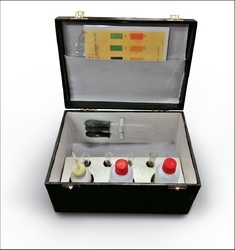Importance of Acidity in Insulating Oil
Oxidation Effects On oils
Acidity Test Kit
We can determine the acidity of transformer insulating oil, by a simple portable acidity test kit. It consists of one polythene bottle of rectified spirit (ethyl alcohol), one polythene bottle of sodium carbonate solution and one bottle of universal indicator (liquid). It also consists of clear and transparent test tubes and volumetrically scaled syringes.
Measure Acidity of Insulating Oil
The acidity of insulating oil is generally measured by the required quantity in milligram of KOH to entirely neutralize the acidity of a specific quantity in a gram of the oil. The acidity of an insulating oil is 0.3 mg KOH / g means 0.3 milligram of KOH is required to neutralize 1 gram of that insulating oil.
When a Fix quantity of alkali is added to a fixed quantity of oil, the oil will either become acidic, neutral or alkaline depending upon the quantity of acid present in the sample. If the fixed quantity of added alkali is just same as the quantity of alkali required to neutralize the acid presents in the oil sample, the oil will have pH value of 7.
Also Read: WORKING AND IMPORTANCE OF BUCHHOLZ RELAY
If the fixed quantity of added alkali is more than that required to neutralize entire acid in the oil sample, the oil becomes alkaline and it will have any pH value from 8 to 14 depending upon the quantity of acid was present in the oil.
If the fixed quantity of added alkali is less than that required to neutralize entire acid in the oil sample, the oil becomes acidic and it will have any pH value from 0 to 6 depending upon the quantity of acid was present in the oil.
The universal indicator is a chemical solution which gives different colors for different pH values of the oil. So, we can visually determine the pH value of the sample, hence the acidic nature of the oil by viewing its colors.
Procedure of Acidity Test for Insulating Oil
- For that, we have first to take exactly 1 gram of insulating oil. We normally do this by taking 1.1 milliliter of the oil to be tested by provided volumetric syringe. Actually, 1.1 milliliter oil is taken as 1 gram of oil.
- Before test, we have to extract the dissolved acid in the oil. That we do by adding exactly 1 ml of rectified spirit (ethyl alcohol) in the test sample. This is because the acid produced in the mineral oil is highly soluble in the alcohol.
- After shaking the test sample well we add 1 ml of sodium carbonate in the sample. Sodium carbonate is the most suitable alkali for that purpose because it does not change its characteristics much when comes in contact with the atmosphere during use.
- At last, after re-shaking the sample mixture we have to add 5 drops of universal indicator in the sample.
Also Read: TYPES OF TRANSFORMER
The color of the sample oil after mixing rectified spirit, sodium carbonate and universal indicator, describes the value of acidity of the oil sample in mg KOH / g as follows.





